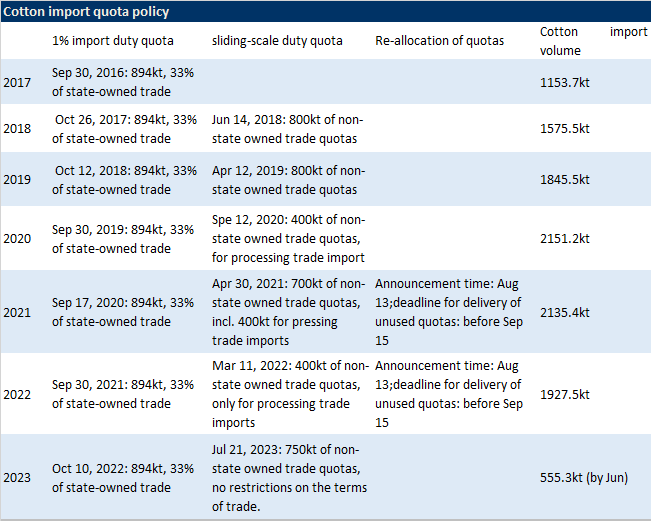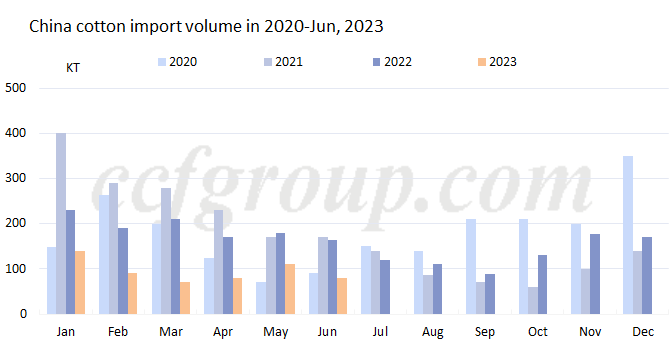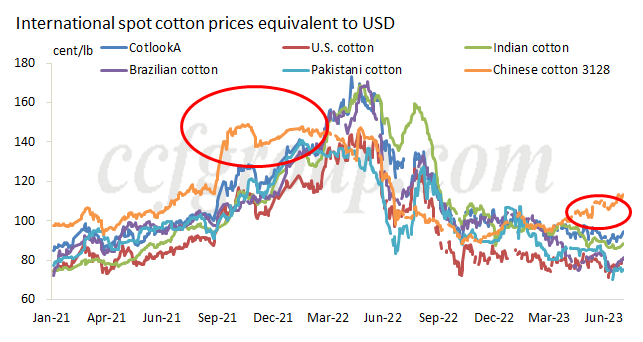China to allocate 750kt of sliding-scale duty quotas to curb cotton prices
Due to low temperatures and extreme weather conditions, there are expectations of lower 2023/24 Xinjiang cotton production and the delay of arrivals. Meanwhile, some market institutions have conducted research and found that Xinjiang cotton inventory is much lower than official data, which has raised concerns about domestic cotton supply in Sep. As a result, both cotton futures and spot prices have surged. The operating environment for downstream textile enterprises has rapidly deteriorated. To effectively control cotton prices and bring them back to a reasonable level, the 750kt of sliding-scale quotas was announced to be released last Friday. Taking into account the relatively low cotton imports in the first half of the year, the issuance of the sliding-scale quotas is relatively large. Additionally, the implementation of the state cotton reserves sales indicates the strong determination of policy makers to curb cotton price increases in the near term.
1. The quantity of sliding-scale duty quotas is higher compared with cotton imports in the first half year
In previous years, the announcement of the sliding-scale quota policy was usually made between Apr and Sep, with most announcements occurring between Apr and June. This year, the announcement was relatively late, possibly indicating a deliberate coordination with the state cotton reserves sales policy to curb the rise in cotton prices and reduce the price difference between Chinese domestic and international cotton.

Looking at cotton imports in the first half of 2023, the volume was at its lowest compared to the same period in previous years. From Jan to Jun, cumulative imports amounted to 555,300 tons, a 51.09% decrease compared to the same period the previous year, and a 48.9% decrease compared to the five-year average for the same period (1.0866 million tons). According to seasonal patterns, cotton imports in the first half of the year are usually higher than in the second half. Although cotton imports are expected to increase significantly in the second half of this year, even if we consider the highest import volume in the past decade, which occurred in the second half of 2020 at 1,255,200 tons, the allocation of 890,000 tons for the 1% quota and 750,000 tons for the sliding-scale quota would be barely sufficient. Historically, normal import volumes in the second half of the year range from 650,000 to 900,000 tons. Therefore, from a quantitative perspective, the cotton import quota for the year 2023 is likely to be surplus. The arrangement of such a large import volume also indicates that policymakers intend to promote cotton imports in the second half of the year to balance the price difference between domestic and international cotton, protect the downstream textile and garment industry, and stabilize the domestic employment environment.

2. Price spread between Chinese and international cotton continues to expand
Currently, there is a discrepancy in cotton supply and demand between China and overseas markets. Overseas, with the unexpected abundant production in Brazil and Australia, the supply of cotton in the third quarter is sufficient, which helps restrain the upward trend of the cotton futures market in the United States. While the domestic cotton market in China has a strong bullish sentiment. The market has reacted ahead of the anticipated peak harvesting period for the 2023/2024 season, and cotton prices have risen prematurely, even during the traditional off-season for textile production. The increase in cotton quotas aims to ease the supply pressure in the domestic cotton market during the third quarter, and to narrow the price difference between domestic and international cotton, which is crucial to providing relief to downstream export-oriented enterprises.

3. Downstream spinners' profits keep weakening, and spinners may reduce operating rate
More small and medium spinners shut down or cut operating rate in face of unfavorable profits. Large spinning mills have not reduced the operating rate largely, but they reflect yarn sales are slow and inventory is accumulating. It is not ruled out that after a period of time, some large spinners may begin to reduce their operating rate due to the poor business conditions.
There are different interpretations and understandings among market participants regarding the state cotton reserves sales and sliding-scale duty quota policies. The contradiction lies in the cotton supply from Sep to Nov, before intensive arrivals of new cotton. In short, Chinese cotton prices may be volatile, and there will be intense battles between bulls and bears.
- Top keywords
- Cotton Price
- Cotton Futures Price
- Cotton Futures
- CZCE
- PTA Futures Price
- Chemical Fiber
- Polyester Prices
- Wool price
- PTA Futures
- Shengze Silk
- China
- Yarn Price
- price
- China Textile City
- Fibre Price
- Benzene Price
- Cotton
- Index
- Cotton Index
- PTA
- fabric price
- NYMEX
- Top 10
- textile industry
- Spot Cotton
- Cotton Yarn
- Polyester Price
- Futures
- PTA Price
- cotton yarn price

